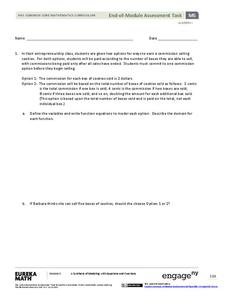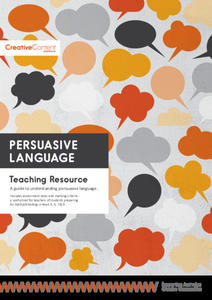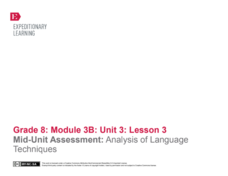Curated OER
Looking and Learning in the Art Museum
Have you just visited an art museum? Or can you create a gallery in your classroom to visit? Pupils create an original drawing that reinforces what was learned in a visit to the art museum. They will view original art work and verbally...
Curated OER
Mystery of Mirrors: Discovery Stations
Hands-on stations in which groups of primary learners experience what mirrors can do provide opportunities for experimenting and authentic discovery. Recording their observations in complete sentences seems age-inappropriate. Drawing...
Curated OER
Nomenclature Worksheet - Acids
View empirical formulas for eighteen different acids and write their chemical names, then read the names of twenty acids and write their chemical formulas. All that you see on the worksheet is a tidy list of each, but no instructions....
Curated OER
Coastal Erosion Diagrams
A set of super-descriptive and colorful slides demonstates the effects of ocean waves on coastal cliffs. You will need to do the verbal explanation, as little text is found on some of the slides, but the graphics really illuminate how...
Curated OER
ASL Lesson 2
Empower your non-verbal, autistic, or learning-impaired child with sign language. Lesson 2 in this functional and straight-forward series focuses on vocabulary related to familial relationships and ASL grammar. Video clips and images of...
Curated OER
ASL Lesson 4
Provide your hearing-impaired or special-needs students with a functional ASL vocabulary focused on feelings and family. Lesson 4 in this extensive series allows you to view both images and videos of each word or sentence as it is...
Curated OER
ASL: Lesson 5
Sign language is an effective way to communicate with those special needs, hearing, impaired, and non-verbal pupils. This lesson provides a highly structured way to learn or teach ASL. Included are multiple links to images, descriptions,...
Curated OER
ASL: Lesson 12
Interested in learning ASL? Lesson 12 in this ASL series gets you ready to identify the days of the week, ask question, and modify time signs. Note: If you are a special eduction teacher, use the vocabulary list to teach your non-verbal...
Curated OER
ASL: Lesson 19
Being able to express feelings is important for every learner. ASL lesson 19 is intended for teaching hearing impaired pupils or special ed teachers functional ASL. Since this provides a list of signs describing feelings, it would be a...
Curated OER
Grocery Shopping
Using an adaptive shopping list, special needs students take a trip to the grocery store. Instead of words, their list contains pictures of the items they need to find and purchase at the store. They run through several practice and...
Curated OER
Fire Safety Skills
Here is a fire safety instructional activity specifically designed for blind or visually impaired teens. They will attempt to exit the building safely, feeling for hot spots, heat drafts, and obstacles. A hairdryer, tape recorded fire...
Association for Supervision and Curriculum Development (ASCD)
Interpreting Algebraic Expressions
The title of this lesson should be "Algebraic Expressions Four Ways." Not only will your class be translating verbal descriptions of algebraic expressions to symbols, but also working with their geometric interpretation via area as well...
Do2Learn
Social: Behavior
What does "good behavior" look like? Set clear guidelines for what type of behavior is expected in different situations, and ensure your learners understand the verbal cues that you provide.
EngageNY
End-of-Module Assessment Task - Algebra 1 (Module 5)
This unit assessment covers the modeling process with linear, quadratic, exponential, and absolute value functions. The modeling is represented as verbal descriptions, tables, graphs, and algebraic expressions.
Scholastic
Tell Us a Tale: Teaching Students to Be Storytellers
Encourage scholars to retell their favorite short story or folktale, adding personal details to make it their own. After reading their book of choice several times, story tellers retell a tale verbally to their classmates.
EngageNY
Writing Addition and Subtraction Expressions
Symbols make everything so much more concise. Young mathematicians learn to write addition and subtraction expressions — including those involving variables — from verbal phrases. Bar models help them understand the concept.
EngageNY
Writing Division Expressions II
Division is division is division is division ... four different ways to write division. Scholars continue to learn about division expressions. They translate between several forms, including verbal phrases, expressions using the division...
EngageNY
Read Expressions in Which Letters Stand for Numbers II
Reading and writing take on a whole different meaning in math class. Young mathematicians learn to read verbal phrases by focusing on operation words. They write equivalent algebraic expressions for both mathematical and contextual...
EngageNY
Read Expressions in Which Letters Stand for Numbers III
Those key operation words sure come in handy. Groups continue their work with converting between different notations for algebraic expressions. They work in stations to write the symbolic form for given verbal phrases. This is the 17th...
Lemos and Crane
Homophobic Bullying
Discuss homophobia and bullying with a collaborative and supportive lesson. Class members engage in a series of activities focused on the ways bullies use physical, verbal, mental and emotional, sexual, and cyber tactics to spread...
Creative Content Australia
Persuasive Language
Language has power. Use the materials in a language arts teaching guide to equip learners with the knowledge of the persuasive techniques, both verbal and visual, that can be used to influence thinking.
EngageNY
Mid-Unit Assessment: Analysis of Language Techniques
Show what you know. Learners demonstrate mastery of English grammar and usage by completing a pen-and-paper assessment of verbals and verb shifts. In addition, they begin composing a book review based on an independent reading book. The...
EngageNY
Presenting a Research-Based Claim: Effective Speaking Techniques
Take note. Scholars receive their claim drafts back to revise and write their claims and three pieces of evidence on notecards. They save the notecards to use when the verbally present their claims to the class. At the end, individuals...
Flipped Math
True False Equations
Determine what makes the equation true. Learners view an instruction video on determining what values make an algebraic equation true. The pupils describe the solution set using three different methods: verbally, set notation, and...
Other popular searches
- Verbal Communication
- Non Verbal Communication
- Examples of Verbal Irony
- Non Verbal Communication
- Algebra 2 Verbal Equations
- Verbal Communication Skills
- Verbal Irony
- Non Verbal Language
- Verbal Irony Cartoons
- Verbal Expressions
- Verbal Demonstration
- None Verbal Communication























